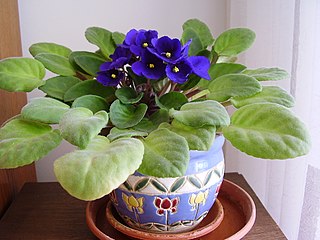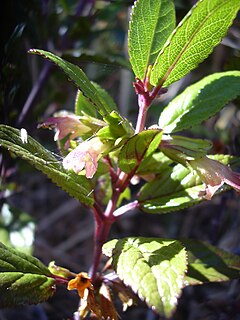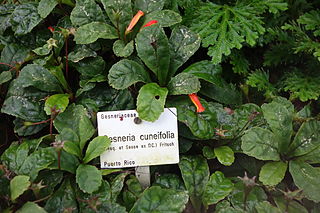
Gesneriaceae, the African violet family, is a family of flowering plants consisting of about 152 genera and ca. 3,540 species in the Old World and New World (Gesnerioideae) tropics and subtropics, with a very small number extending to temperate areas. Many species have colorful and showy flowers and are cultivated as ornamental plants.

Gesneria is a genus of approximately 50 species in the flowering plant family Gesneriaceae. Except for two or three odd South American species, all are native to islands of the Caribbean. The genus is classified in the tribe Gesnerieae along with the genera Bellonia, Pheidonocarpa, and Rhytidophyllum. Gesneria species are usually woody shrubs or subshrubs, and are unusual in the family in having alternately arranged leaves. A complete list of the accepted species and their synonyms can be found in the Smithsonian Institution's World Checklist of Gesneriaceae.

Baptisia is a genus in the legume family, Fabaceae. They are flowering herbaceous perennial plants with pea-like flowers, followed by pods, which are sometimes inflated. They are native to woodland and grassland in eastern and southern North America. The species most commonly found in cultivation is B. australis.

The herbaceous perennial plant Gentiana calycosa is a species of gentian known by the common names Rainier pleated gentian and mountain bog gentian.
Gesneria calycina is a species of plant in the family Gesneriaceae. It is endemic to Jamaica.
Gesneria exserta is a species of plant in the family Gesneriaceae. It is endemic to Jamaica.

Salvia gesneriflora is a herbaceous perennial or subshrub native to mountainous provinces of the Sierra Madre Oriental in Mexico, growing at 7,500–10,000 ft elevation. It was named for Gesneria-like flower. The genus Gesneria is named in honor of 15th-century Swiss botanist Conrad Gessner. The long tubular flowers of this salvia resemble Gesneria flowers. It is a popular ornamental plant.
Gesneria is a genus of moths of the family Crambidae.

Sidalcea calycosa is a species of flowering plant in the mallow family known by the common names annual checkerbloom, checker mallow, and vernal pool checkerbloom.
Udea despecta, the Hawaiian sweetpotato leafroller, is a moth of the family Crambidae. It is endemic to the Hawaiian islands of Kauai, Oahu, Molokai, Maui, Lanai and Hawaii.
Gesneria pauciflora is a rare species of flowering plant in the family Gesneriaceae known by the common name yerba maricao de cueva. It is endemic to Puerto Rico, where there are only three populations remaining. It was federally listed as a threatened species of the United States in 1995.

Stenogyne is a genus of flowering plants in the mint family first described in 1830. The entire genus is endemic to Hawaii.
- Stenogyne angustifoliaA.Gray - narrowleaf stenogyne
- Stenogyne bifidaHillebr. - twocleft stenogyne - Molokai
- Stenogyne calaminthoidesA.Gray - bog stenogyne - Big Island
- Stenogyne calycosaSherff - Maui
- Stenogyne campanulataWeller & Sakai - Kalalau Valley stenogyne - Kauai
- †Stenogyne cinereaHillebr - Maui but extinct
- Stenogyne cranwelliaeSherff - Big Island
- †Stenogyne haliakalaeWawra - Maui but extinct
- Stenogyne kaalaeWawra - Oahu
- Stenogyne kamehamehaeWawra - Molokai, Maui
- Stenogyne kanehoanaO.Deg. & Sherff - Oahu stenogyne - Oahu
- Stenogyne kauaulaensisK.R.Wood & H.Oppenh. - Maui
- Stenogyne kealiaeWawra - Kauai
- Stenogyne macranthaBenth. - Big Island
- Stenogyne microphyllaBenth. - Maui, Big Island
- †Stenogyne oxygonaO.Deg. & Sherff - Big Island but extinct
- Stenogyne purpureaH.Mann - Kauai
- Stenogyne rotundifoliaA.Gray - pua'ainaka - Maui
- Stenogyne rugosaBenth. - ma'ohi'ohi - Maui, Big Island
- Stenogyne scrophularioidesBenth. - mohihi - Big Island
- Stenogyne sessilisBenth. - Lanai, Maui, Big Island
- †Stenogyne viridisHillebr. - Maui but extinct

Gesneria centuriella is a species of moth in the family Crambidae described by Michael Denis and Ignaz Schiffermüller in 1775. It is found from Europe, east to Japan. It is also present in Greenland and northern North America.
Gesneria rindgeorum is a species of moth in the family Crambidae described by Eugene G. Munroe in 1972. It is found in the US states of Utah, Wyoming, Montana and Washington.

Scopariinae is a subfamily of the lepidopteran family Crambidae. The subfamily was described by Achille Guenée in 1854.
Asketanthera is a genus of plants in the family Apocynaceae first described as a genus in 1878. It is native to the West Indies.

Gesneria cuneifolia is a plant species in the family Gesneriaceae.

The Gesnerioideae are a subfamily of plants in the family Gesneriaceae: based on the type genus Gesneria. Although genera typically originate in the New World, some species have become widely distributed as ornamental plants.










